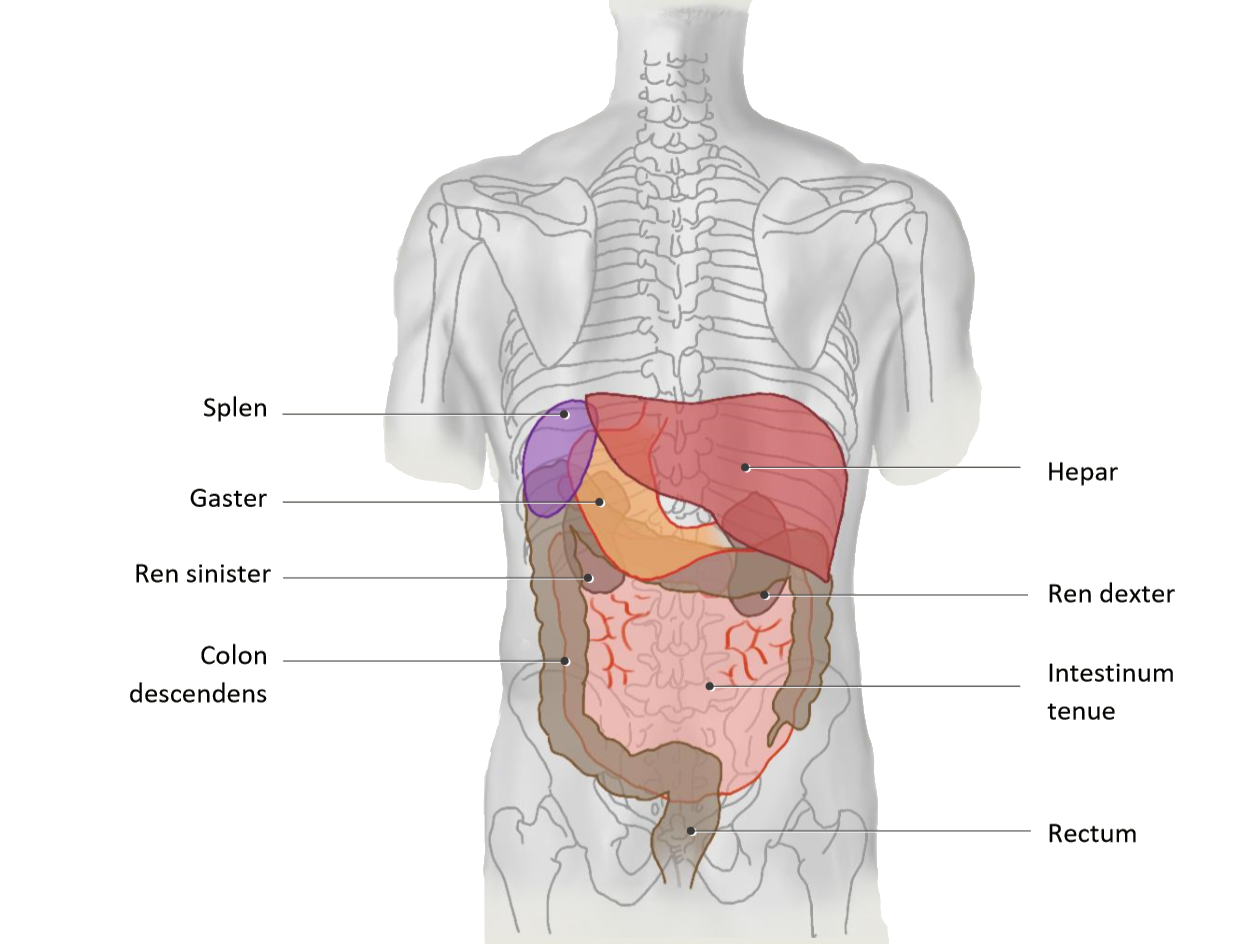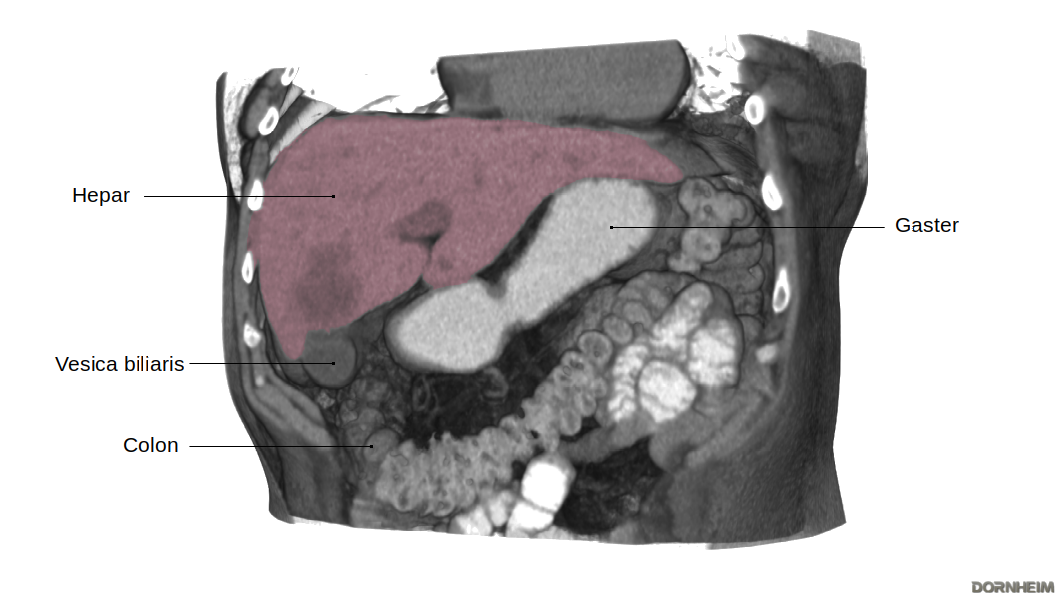Leber (Hepar)/en: Unterschied zwischen den Versionen
Becher (Diskussion | Beiträge) (Die Seite wurde neu angelegt: „<div class="clear"></div> ===Liver in situ=== <div class="thumb tright thumbinner"> <div class="picture"> <lightbox-embedding src="file:LeberSchnittHorizontal.…“) |
Becher (Diskussion | Beiträge) (Die Seite wurde neu angelegt: „The thin area of tissue between the liver and the curvature of the stomach is called the omentum minus. This serous skin lines the peritoneal cavity and is the…“) |
||
| Zeile 81: | Zeile 81: | ||
</div> | </div> | ||
| − | + | The thin area of tissue between the liver and the curvature of the stomach is called the omentum minus. This serous skin lines the peritoneal cavity and is the ventral border of the bursa omentalis. This is bordered on the right by the liver.<br> | |
| − | + | The downward-facing liver margin is sharp-edged and easily palpable in an enlarged liver. The liver extends from the right regio hypochondriaca, through the regio epigastrica, and into the left upper abdomen. The stomach can be seen at the left inferior border of the liver. The gallbladder lies on the underside of the liver and overhangs the inferior border of the liver.<br> | |
<div class="clear"></div> | <div class="clear"></div> | ||
Version vom 13. Dezember 2021, 13:46 Uhr
The liver is the largest digestive gland in the human body. Due to its function and tasks it is the central organ of metabolism. It forms important proteins and detoxifies the body. Almost all nutrients that are absorbed through the intestines are first passed through the liver.
Anatomy
Projection
The liver is located in the right upper abdomen, but extends beyond the epigastrium into the left upper abdomen. It thereby pushes far in front of the stomach, which leaves an impression (impressio gastrica) at the back of the left liver lobe. The right lobe of the liver comes into close contact with the colon (right flexure), the small intestine (pars superior), the upper part of the right kidney and the right adrenal gland. Its impression sites are also named accordingly: Impressio colica, duodenalis, renalis and suprarenalis. The position of the liver is strongly dependent on respiration, as its underside is fused to the diaphragm. Age and posture are equally crucial in determining the position of the liver. The gallbladder is located dorsally between the left and right lobes of the liver.
Liver in situ
The thin area of tissue between the liver and the curvature of the stomach is called the omentum minus. This serous skin lines the peritoneal cavity and is the ventral border of the bursa omentalis. This is bordered on the right by the liver.
The downward-facing liver margin is sharp-edged and easily palpable in an enlarged liver. The liver extends from the right regio hypochondriaca, through the regio epigastrica, and into the left upper abdomen. The stomach can be seen at the left inferior border of the liver. The gallbladder lies on the underside of the liver and overhangs the inferior border of the liver.
Lebersegmente
Die Lebersegmente werden von insgesamt 8 funktionellen Untereinheiten der Leber gebildet. Jede dieser Einheiten besitzt einen Ast der Pfortader, des Gallenganges und einen Segmentast der Arteria hepatica propria.
Zuordnung zu Partes und Divisiones
| Pars hepatis sinistra | |
|---|---|
| Segment I | Pars posterior hepatis, Lobus caudatus |
|
Divisio lateralis sinistra |
| Segmentum mediale sinistrum (= Segmentum IV) untergliedert in Segment IVa und IVb |
Divisio medialis sinistra |
| Pars hepatis dextra | |
|---|---|
|
Divisio medialis dextra |
|
Divisio lateralis dextra |
Da jede Untereinheit ihren eigenen Versorgungsweg besitzt, können die Lebersegmente einzeln chirurgisch entfernt werden. Die Leber ist nach der Entfernung einer Untereinheit immer noch funktionsfähig, sowie die entfernten Untereinheiten selbst. Dies macht eine Teilimplantation einer Leber möglich.
Verschiedene Ansichten
| Sicht von dorsal auf die Pars superior der Facies diaphragmatica | Sicht von ventral auf die Facies diaphragmatica | Sicht von kaudal auf die Facies visceralis |
|
Der größte Teil der Leberoberfläche ist umgeben mit viszeralem Peritoneum. Jedoch bleibt die Area nuda als einzige peritonealfrei, ihre Oberfläche bildet die bindegewebige Kapsel. Außerhalb der Peritonealabdeckung verlassen die meist drei Vv. hepatica die Leber. Eine Besonderheit ist, dass bei der Leber nur die zuführende Arterie und zuführende V. portae hepatis als auch Ductus choledochus im Mesohepaticum verlaufen, die abführenden Venen hingegen nicht. An den Umschlagsorten des viszeralen in das parietale Peritoneum an der Unterseite des Zwerchfells, erscheint das bindegewebige Peritonealepithel als „Strang“ (Lig. coronarium). Aus dieser bindegewebigen Struktur entsteht am linken Leberlappen ein kleiner Zipfel (Appendix fibrosa hepatis). |
Aus der ventralen Ansicht sind die zwei Leberlappen, der große Lobus hepatis dexter und der kleinere Lobus hepatis sinister, gut zu erkennen. Das Lig. falciforme hepatis verläuft zwischen den beiden Lappen. Das Ligamentum falciforme hepatis bildet das Mesohepaticum ventrale und somit die Verbindung zwischen Leber und Bauchwand. |
Die kaudale Sicht ermöglicht einen Blick auf zwei weitere der insgesamt vier Leberlappen: den Lobus caudatus und den Lobus quadratus hepatis. Das Lig. hepatoduodenale dient der Leber zusammen mit dem Lig. hepatogastricum als Mesohepaticum dorsale und gehört topografisch zum Omentum minus. Die Gallenblase überragt den unteren Leberrand mit dem Fundus und liegt der Facies visceralis eng an. Der Hals der Gallenblase zeigt zur Leberpforte, wo sie in Kontakt mit den extrahepatischen Gallenwegen gelangt. |
Funktion
Die Leber hat als größtes und wichtigstes Stoffwechselorgan verschiedene Aufgaben im menschlichen Körper. Sie produziert lebenswichtige Proteine und ist maßgeblich an der Verwertung von Nahrungsbestandteilen sowie dem Abbau und der Ausscheidung von Stoffen beteiligt.
Erkrankungen
Freie Exploration
- Standard
- Fall: 1



